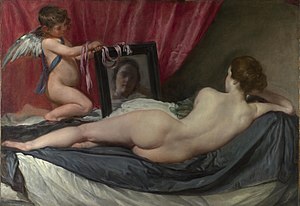Venus in front of the mirror

|
| Venus in front of the mirror |
|---|
| Diego Velázquez , 1648-1651 |
| Oil on canvas |
| 122.5 x 177 cm |
| National Gallery (London) |
Venus in front of the mirror ( Spanish La Venus del Espejo , also known as the Venus of Rokeby ) is a painting by Diego Velázquez from the years 1648–1651 that now hangs in the National Gallery in London . The color scale includes only three basic tones - red, white and gray.
description
Velázquez depicts the goddess Venus lying on a bed with her back to the viewer. She looks into a mirror held by Cupid . Her face, which the mirror shows to the viewer, is slightly blurred and cannot be seen in detail. The blurring of the facial features lets the viewer's gaze rest on the central motif - Venus' body. If he looks up, he sees her face in the mirror, looking directly at him - the voyeur has been caught. The depiction of Venus' face has long been the subject of discussions: technically rather sloppily painted, more hinted at than detailed, it seems to fit poorly with the rest of the canvas. It is a little larger than it should be with 'correct' perspective rendering, and actually the viewer should not be able to see it at all - Cupid holds the mirror in such a way that not Venus' face, but her shame should be reflected there.
It was believed that Velázquez had originally painted a - recognizable - clearer face that had been painted over. This has now been refuted by x-rays from the National Gallery, there is only one layer of paint in the area of the mirror. The geometrical position of the mirror was also simulated in an experiment to show that one could not see the face.
history
The picture is first mentioned in 1651 when it belonged to Gaspar Méndez de Haro (1629–1687). It was intended as a counterpart to a Venetian painting depicting a reclining nymph . She is facing the viewer, her sofa is in the open air, a reversal of the Venus image. In 1800 Venus became the property of Manuel de Godoy , first minister of Charles IV of Spain. He was in the position to be able to hang it between the (probably picked by himself) Goya works The Naked Maja and The Clothed Maja .
In 1813 the painting came to England and was bought by MP John Morritt , who hung it in his Rokeby Hall country house in Yorkshire , which was to give Venus her second name. In 1906 it had to be sold under pressure from inheritance taxes. The National Gallery attempted to buy it with funds from their newly established National Art Collections Fund . It was not immediately possible to raise the requested sum of 45,000 pounds through donations from the population, but King Edward VII donated 8,000 pounds, which triggered another wave of donations from the English. The sum was soon reached, and the king became the patron saint of the National Art Collections Fund .
damage
On 10 March 1914, the militant committed suffragette ( feminist ) Mary Richardson at the National Gallery an attack on the painting, although a security guard had been parked only for this one picture. She smashed the glass with a meat cleaver and then made several cuts on the exposed image. The reason for the attack was the arrest of Emmeline Pankhurst the day before . In a statement to the Women's Social and Political Union (WSPU), she later said: “I have tried to destroy the picture of the most beautiful woman in mythological history as a protest against the Government for destroying Mrs Pankhurst, who is the most beautiful character in modern history ” (translation: “ I tried to destroy the image of the most beautiful woman in mythology, in protest against the government that destroyed Mrs. Pankhurst, the most beautiful figure in modern history ” ). In a 1951 interview, she added: “[I] didn't like the way men visitors gaped at it all day long” (translation : “[I] didn't like the way male visitors gawked at it all day ” ). The painting has been restored and re-exhibited.
More paintings
Remarks
- ↑ Private Life of a Masterpiece - The Rokeby Venus. BBC Wales. IMDB: [1]
- ↑ Private Life of a Masterpiece - The Rokeby Venus. BBC Wales.
- ↑ [2] Website of the National Gallery (English)
- ↑ MARY 'SLASHER' RICHARDSON - Notorious militant retires to Hastings ( Memento of 3 July 2008 at the Internet Archive ) Helena Wojtczak: English Women's History. The 19th and 20th Centuries.
literature
- Rose-Marie Hagen, Rainer Hagen: Eye candy for the pious king. Diego Velázquez: Venus with the mirror, around 1646. In: Rose-Marie Hagen, Rainer Hagen: Masterpieces in detail. (From the Bayeux Tapestry to Diego Rivera). Volume 2. Taschen, Cologne et al. 2005, ISBN 3-8228-4787-9 , pp. 404-409.
- José López-Rey: Velázquez. The artist as a maker. With a catalog raisonné of his extant works. Bibliothèque des arts, Lausanne et al. 1979, pp. 451–452.